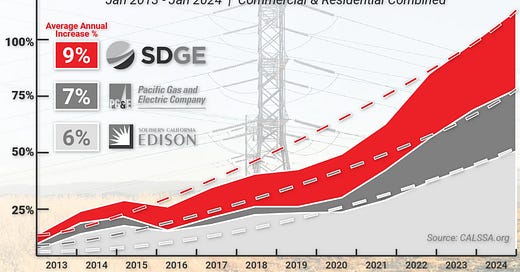Gov. Newsom is recalling the Legislature for an election year special session to investigate why after $28 billion of taxpayer subsidies for the Green New Deal, it is greedy capitalists’ fault that consumer gas and electric bills have almost double.
Governor Newsom wants to hold a show trial to shift blame from his Green New Deal’scausing skyrocketing energy costs by claiming: “Gas price spikes on consumers are profit spikes for oil companies, and they’re overwhelmingly caused by refiners not backfilling supplies when they go down for maintenance.”
California has admitted that its cap-and-trade program has taxed state businesses and consumers at least $28 billion over the last 10 years. About a third of the tax money did pay to subsidize inefficient Green windmills and solar farms. But two thirds of the slush fund was blown on affordable housing, high-speed rail trains and adding zero-emission buses and vans for so-called underserved communities.
California with over 12.5 million customers and $42.2 billion in utility spending is by far the largest utility market in the United States. As a result of Green subsidies, the threemajor utilities’ rates grew over the last decade by 70% for Southern California Edison; 80% for PG&E; and over 100% for San Diego Gas & Electric.
Californians’ average monthly utility bill rose during the period from $195 to $368 per month. Furthermore, Standard & Poors Credit Rating Agency estimates that a third of PG&E’s average household utility bill fund subsidies, with 15% for Green New Deal emissions and another 17.9% for Climate Change wildfire mitigation.
California has fallen from the second to the seventh-largest producer of crude oil among the 50 states. Coupled with Green New Deal subsidies, Californians now pay $4.32 per gallon for gasoline, or about 45% more than Texans.
California continues to be the third largest producer of natural gas, and once had some of the lowest cost consumer prices in the nation. But California Green New Deal subsidies have caused consumer cost for natural gas to double to 16.99 cents per kilowatt hour, justslightly less than the 20.88 cent national average.
Gov. Newsom’s special legislative session wants to force California refineries to pay for building California’s own strategic oil reserve. Newsom proposing the refineries stockpilehuge amounts of gasoline reserves to meet demand whenever refineries are not operatingwould undoubtedly be passed through as higher consumer gas prices.
The election year rhetoric of stopping oil company price gouging may sound attractive to consumers and crude oil storage has proven to be relatively safe. But oil companies have never built massive permanent gasoline storage tanks that would be at risk from earthquakes, lightning strikes and terrorists.
California still derives 50 percent of total energy from petroleum and 30 percent from natural gas, about the same average as the rest of the globe.




